SUPPLY AND DEMAND: — MARKETS AND WELFARE
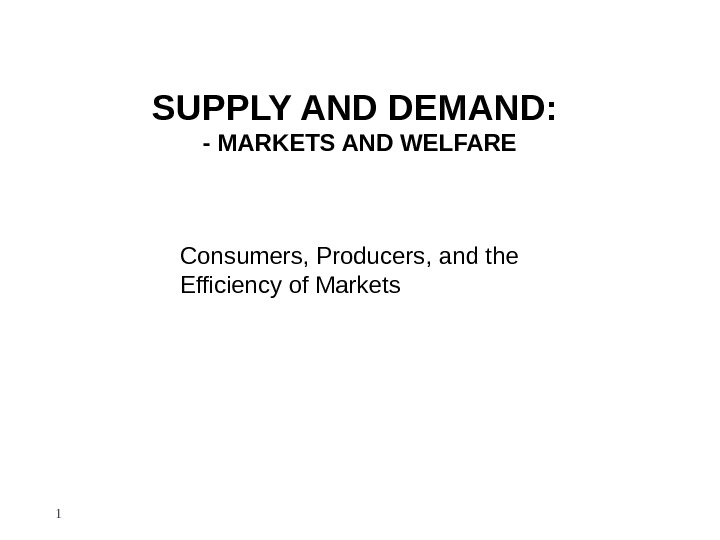

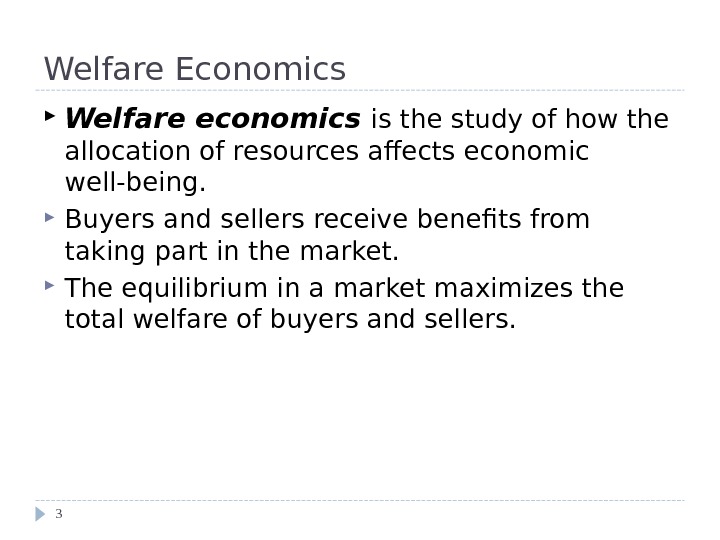
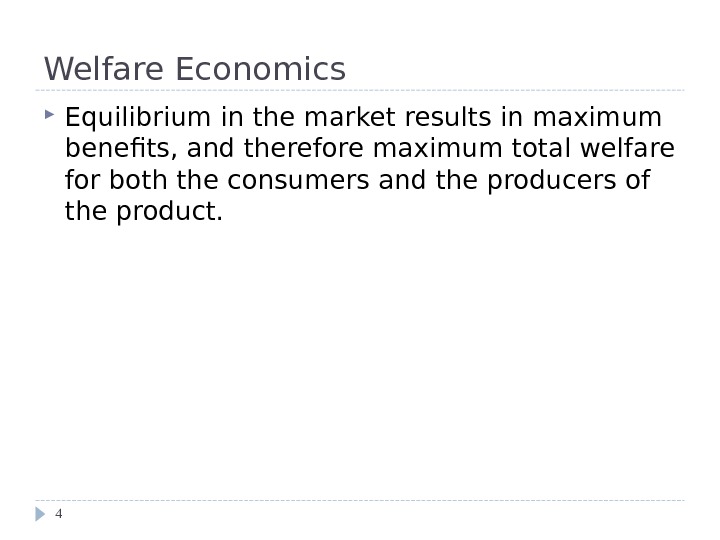
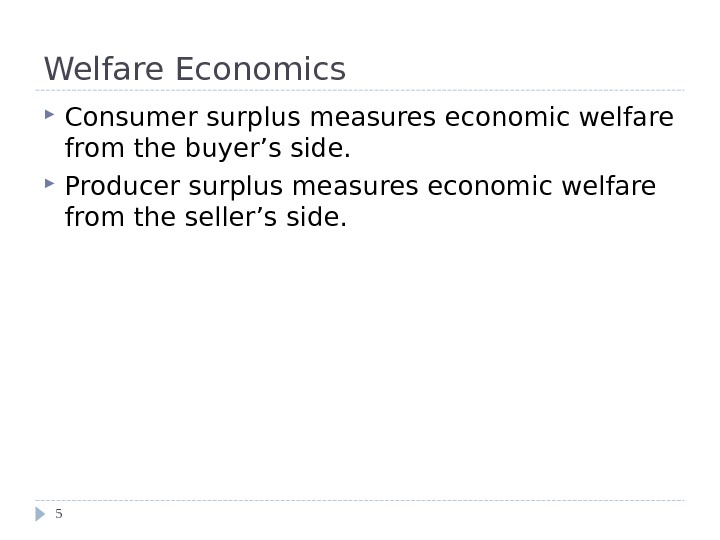
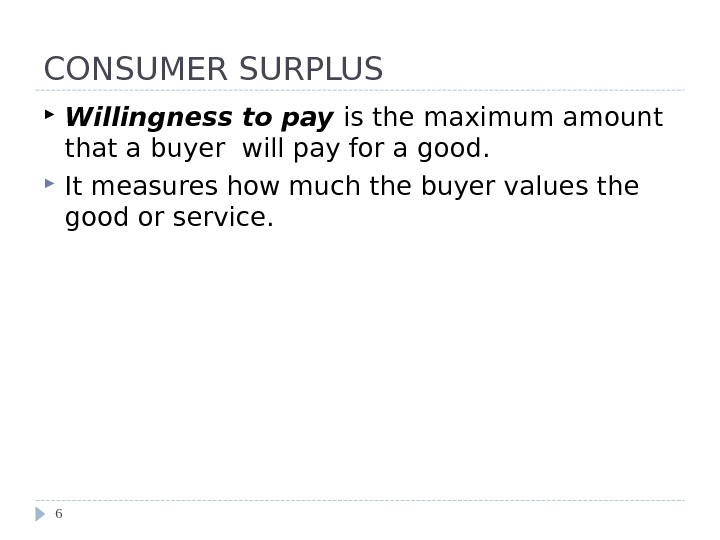
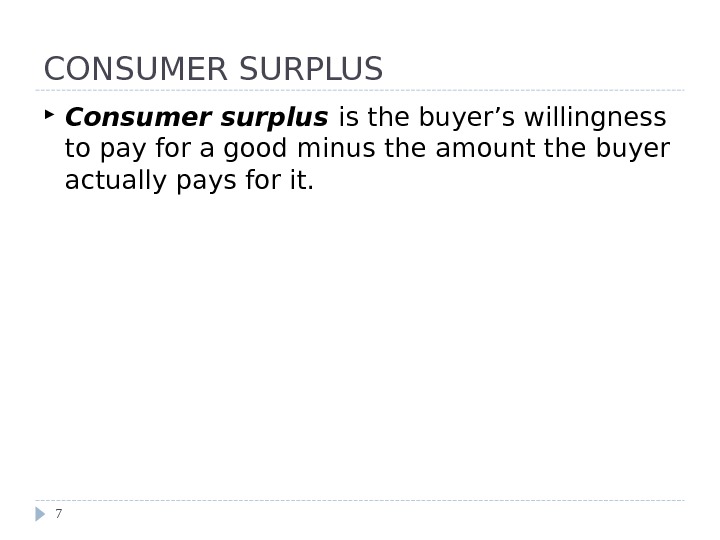
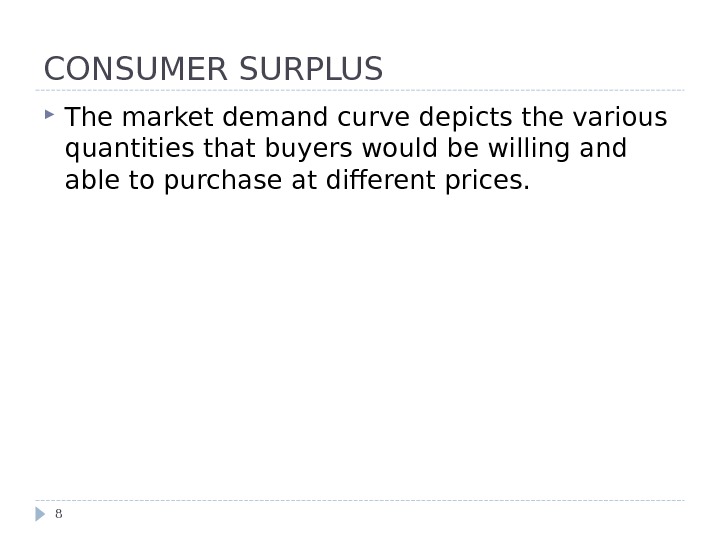
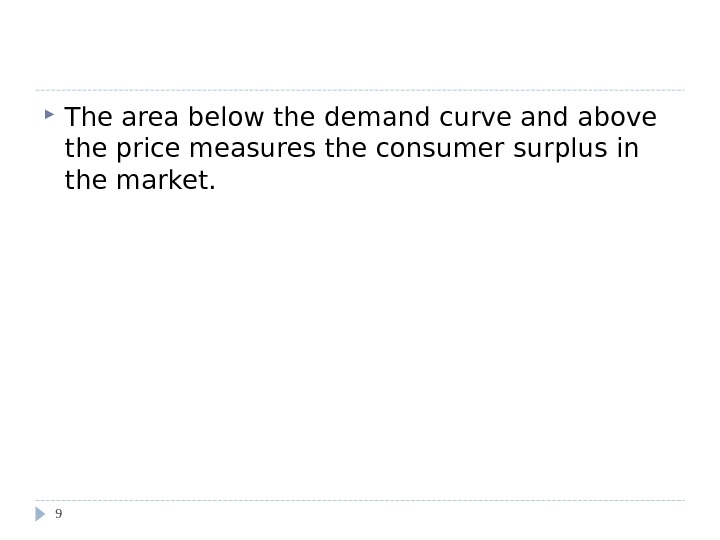
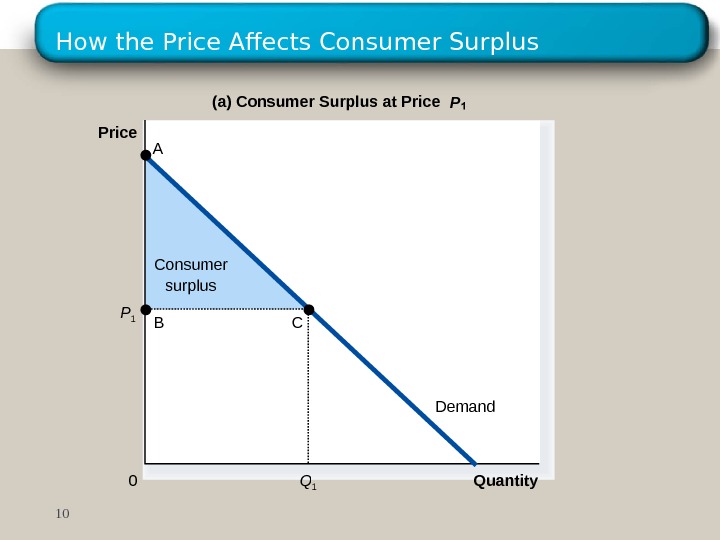
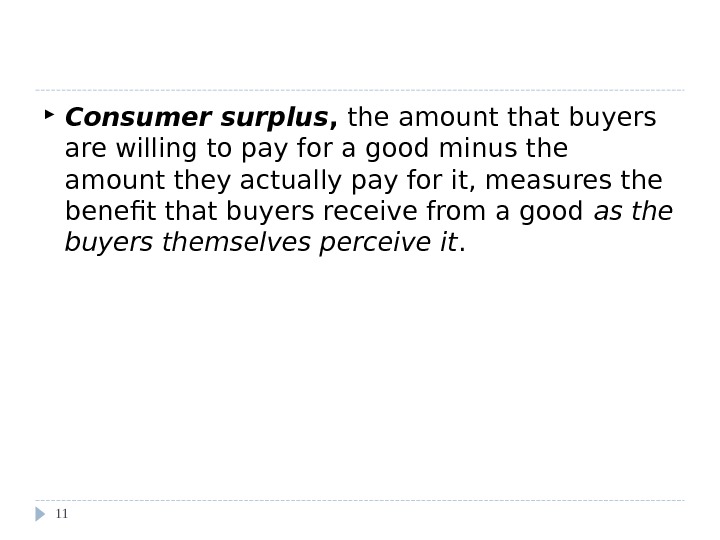
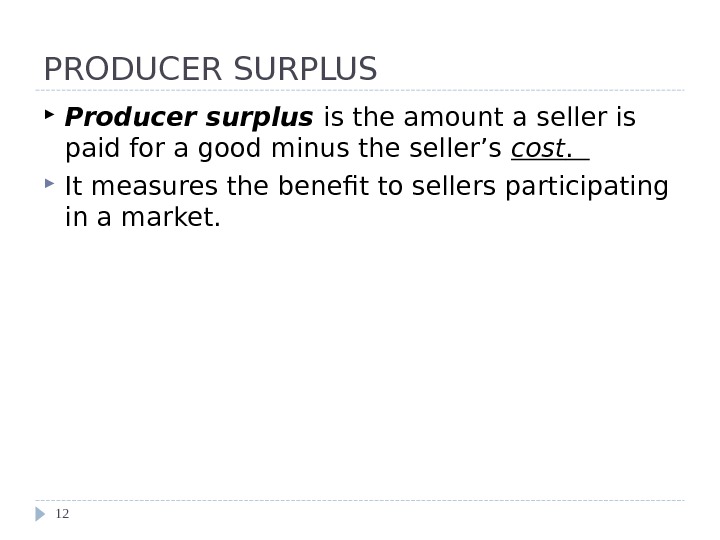
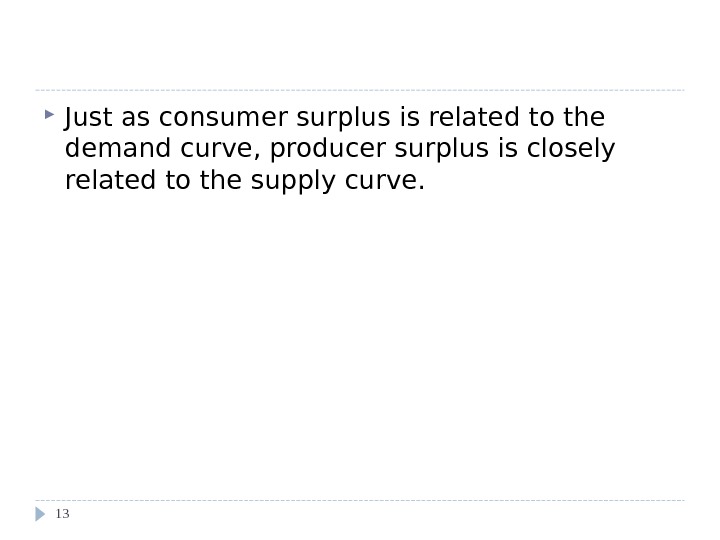
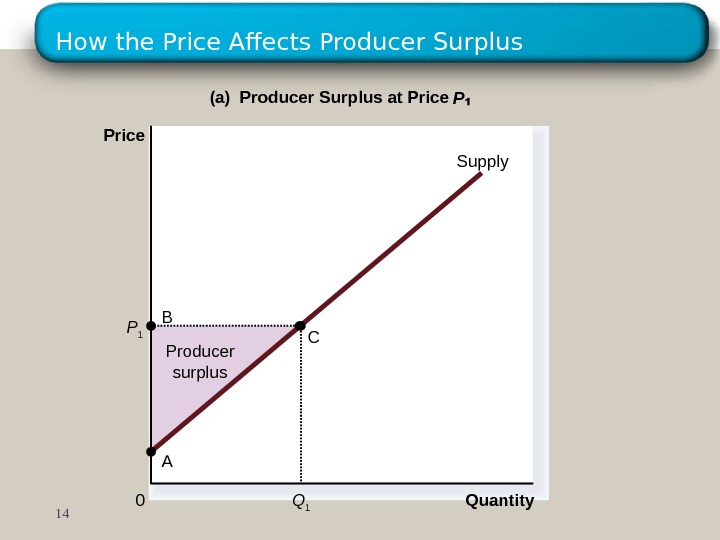
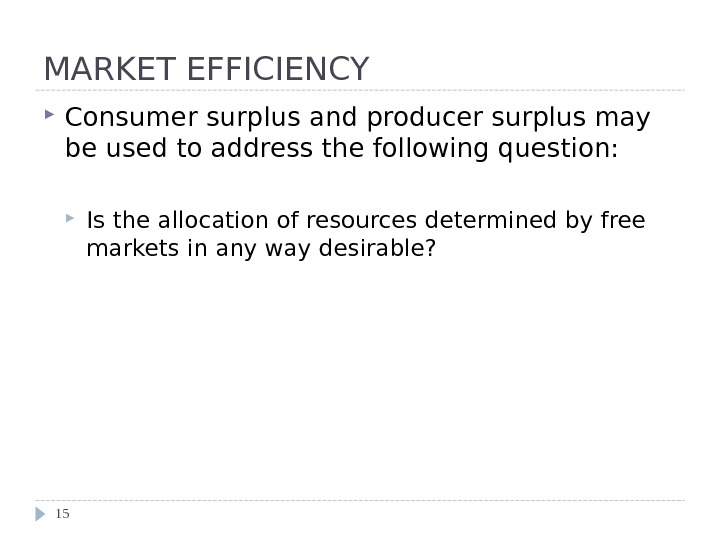
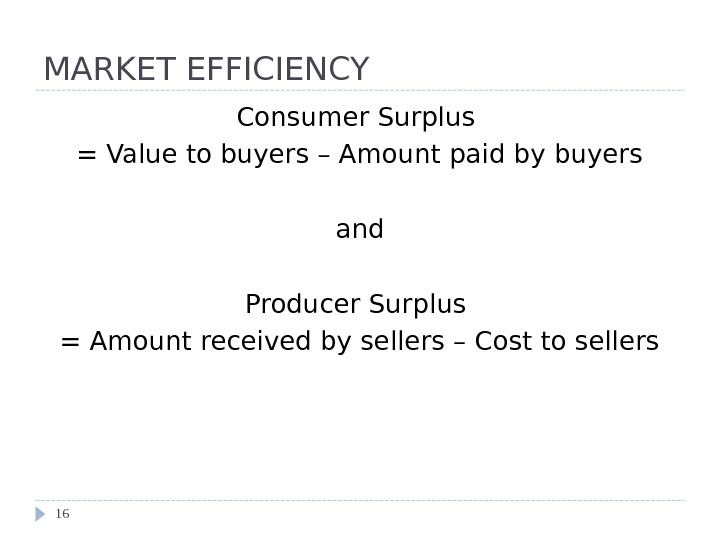
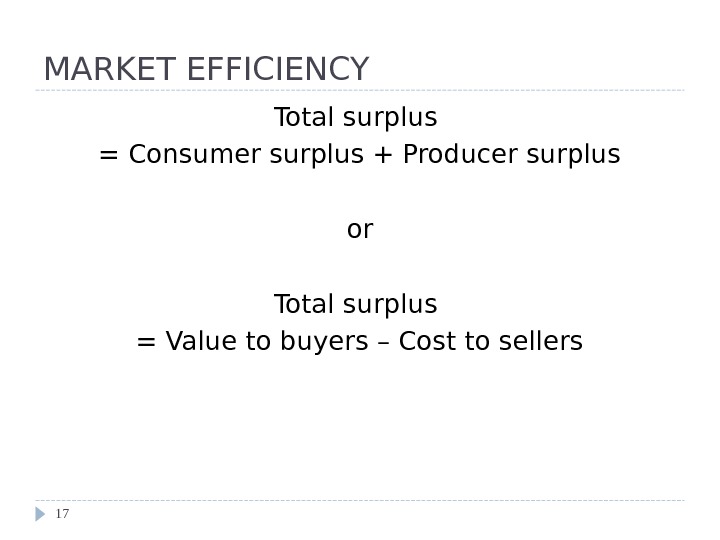
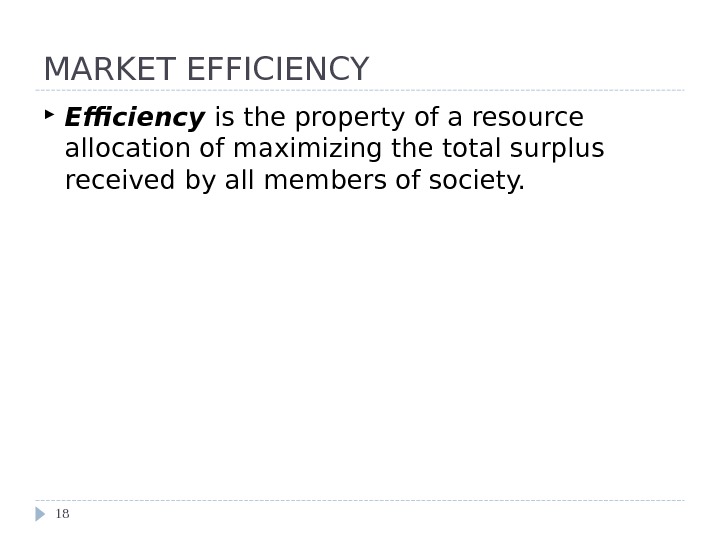
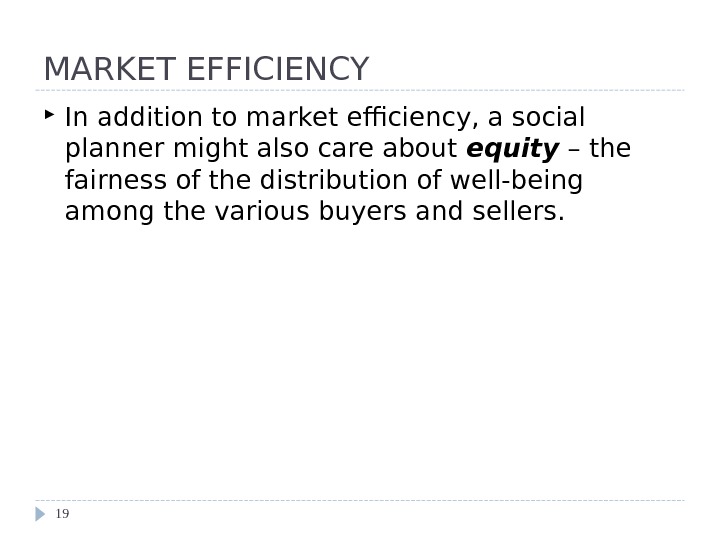
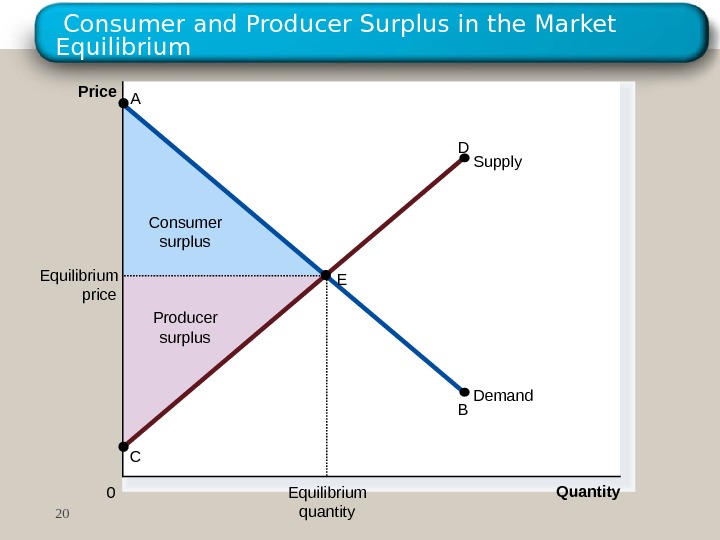
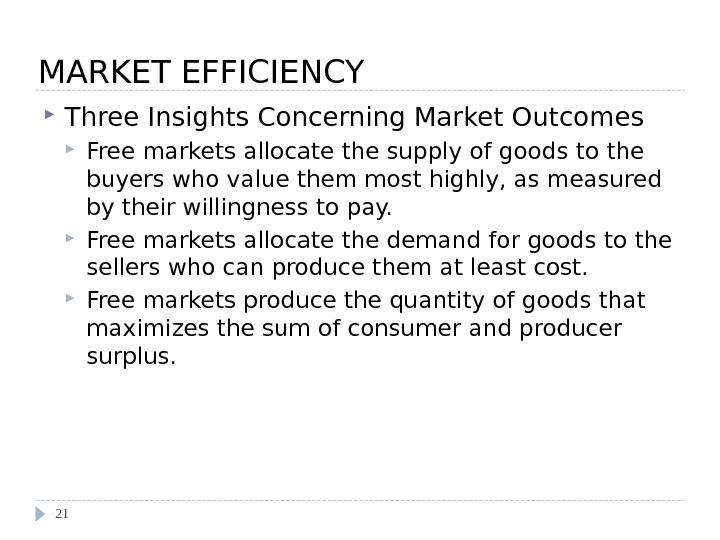
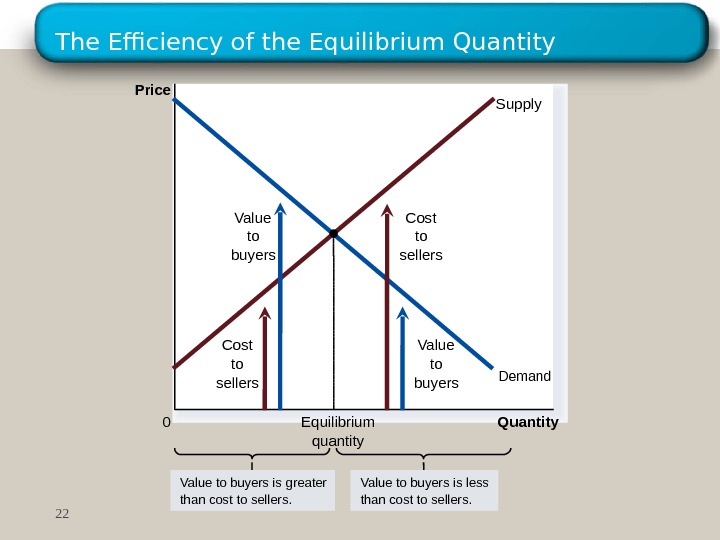
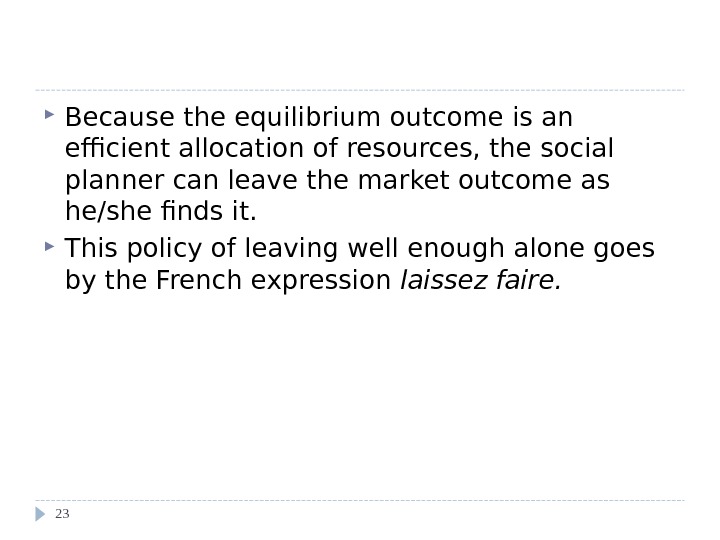
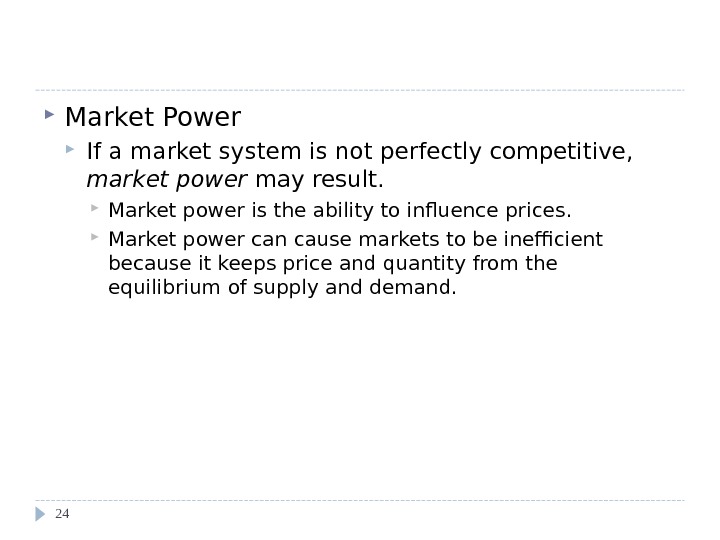
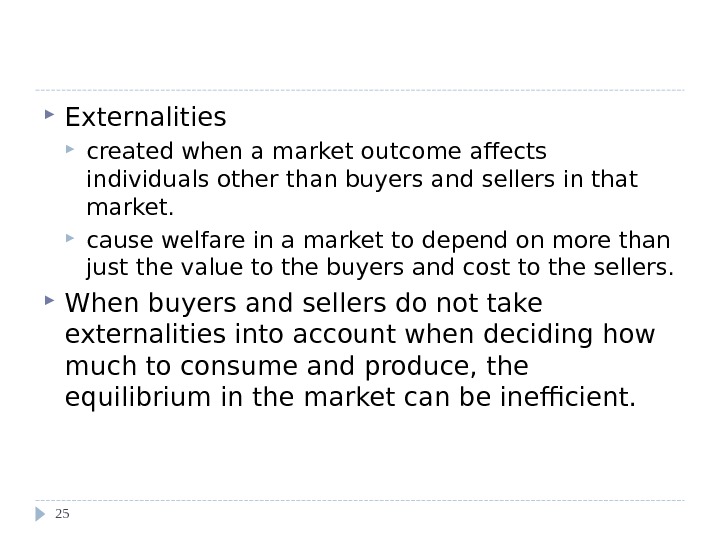
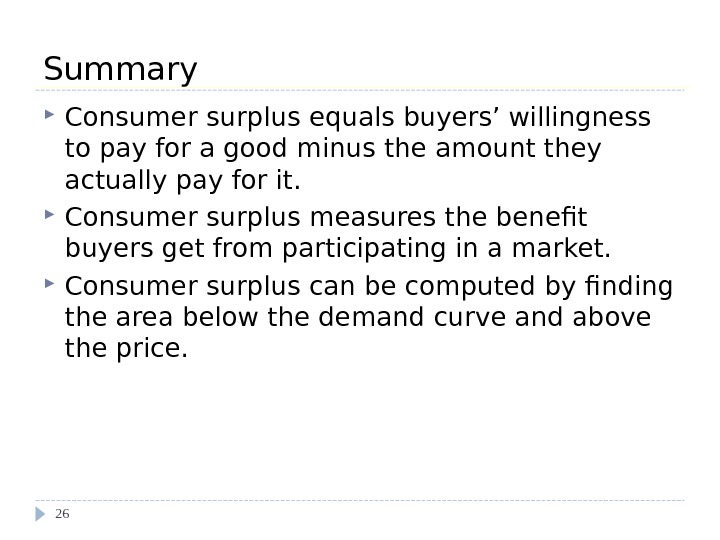
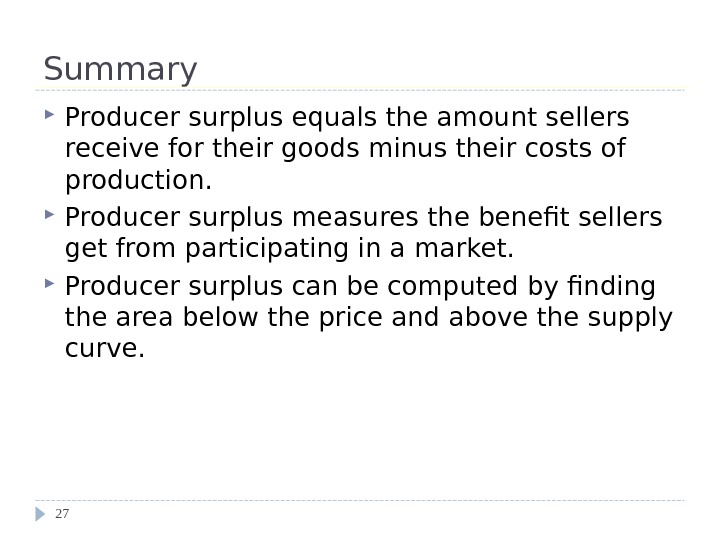
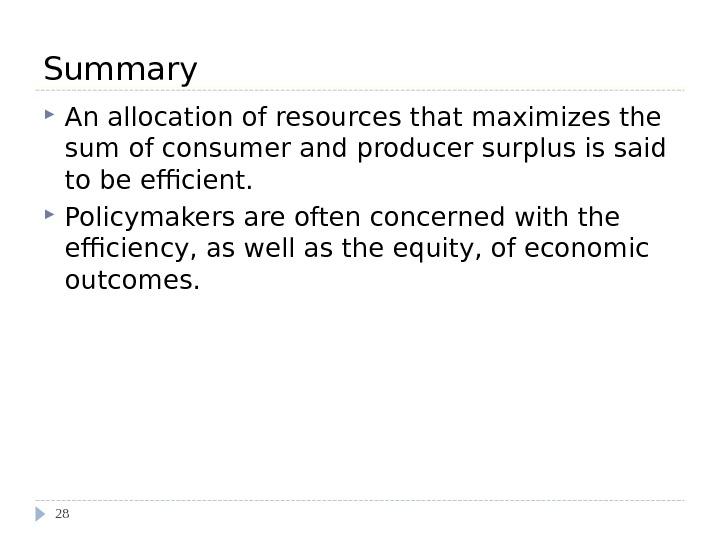
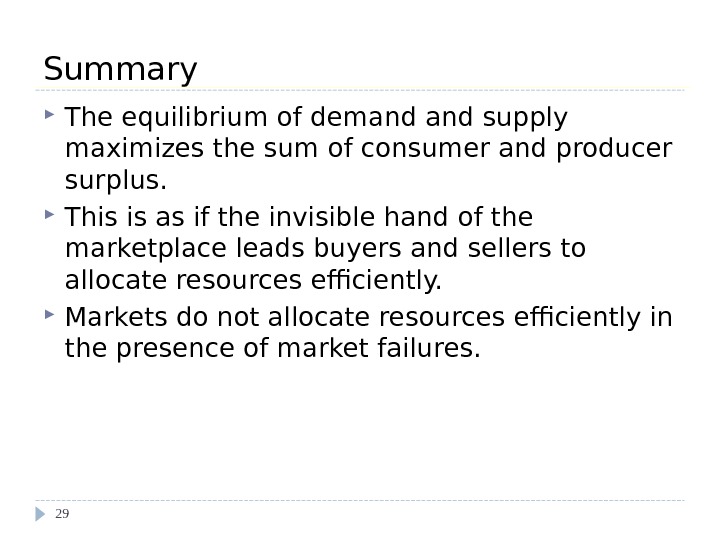
- Размер: 730 Кб
- Количество слайдов: 29
Описание презентации SUPPLY AND DEMAND: — MARKETS AND WELFARE по слайдам
 SUPPLY AND DEMAND: — MARKETS AND WELFARE Consumers, Producers, and the Efficiency of Markets
SUPPLY AND DEMAND: — MARKETS AND WELFARE Consumers, Producers, and the Efficiency of Markets
 REVISITING THE MARKET EQUILIBRIUM Do the equilibrium price and quantity maximize the total welfare of buyers and sellers? Market equilibrium reflects the way markets allocate scarce resources. Whether the market allocation is desirable can be addressed by welfare economics.
REVISITING THE MARKET EQUILIBRIUM Do the equilibrium price and quantity maximize the total welfare of buyers and sellers? Market equilibrium reflects the way markets allocate scarce resources. Whether the market allocation is desirable can be addressed by welfare economics.
 Welfare Economics Welfare economics is the study of how the allocation of resources affects economic well-being. Buyers and sellers receive benefits from taking part in the market. The equilibrium in a market maximizes the total welfare of buyers and sellers.
Welfare Economics Welfare economics is the study of how the allocation of resources affects economic well-being. Buyers and sellers receive benefits from taking part in the market. The equilibrium in a market maximizes the total welfare of buyers and sellers.
 Welfare Economics Equilibrium in the market results in maximum benefits, and therefore maximum total welfare for both the consumers and the producers of the product.
Welfare Economics Equilibrium in the market results in maximum benefits, and therefore maximum total welfare for both the consumers and the producers of the product.
 Welfare Economics Consumer surplus measures economic welfare from the buyer’s side. Producer surplus measures economic welfare from the seller’s side.
Welfare Economics Consumer surplus measures economic welfare from the buyer’s side. Producer surplus measures economic welfare from the seller’s side.
 CONSUMER SURPLUS Willingness to pay is the maximum amount that a buyer will pay for a good. It measures how much the buyer values the good or service.
CONSUMER SURPLUS Willingness to pay is the maximum amount that a buyer will pay for a good. It measures how much the buyer values the good or service.
 CONSUMER SURPLUS Consumer surplus is the buyer’s willingness to pay for a good minus the amount the buyer actually pays for it.
CONSUMER SURPLUS Consumer surplus is the buyer’s willingness to pay for a good minus the amount the buyer actually pays for it.
 CONSUMER SURPLUS The market demand curve depicts the various quantities that buyers would be willing and able to purchase at different prices.
CONSUMER SURPLUS The market demand curve depicts the various quantities that buyers would be willing and able to purchase at different prices.
 Using the Demand Curve to Measure Consumer Surplus The area below the demand curve and above the price measures the consumer surplus in the market.
Using the Demand Curve to Measure Consumer Surplus The area below the demand curve and above the price measures the consumer surplus in the market.
 How the Price Affects Consumer Surplus Consumer surplus Quantity(a) Consumer Surplus at Price P Price 0 Demand. P 1 Q
How the Price Affects Consumer Surplus Consumer surplus Quantity(a) Consumer Surplus at Price P Price 0 Demand. P 1 Q
 What Does Consumer Surplus Measure? Consumer surplus , the amount that buyers are willing to pay for a good minus the amount they actually pay for it, measures the benefit that buyers receive from a good as the buyers themselves perceive it.
What Does Consumer Surplus Measure? Consumer surplus , the amount that buyers are willing to pay for a good minus the amount they actually pay for it, measures the benefit that buyers receive from a good as the buyers themselves perceive it.
 PRODUCER SURPLUS Producer surplus is the amount a seller is paid for a good minus the seller’s cost. It measures the benefit to sellers participating in a market.
PRODUCER SURPLUS Producer surplus is the amount a seller is paid for a good minus the seller’s cost. It measures the benefit to sellers participating in a market.
 Using the Supply Curve to Measure Producer Surplus Just as consumer surplus is related to the demand curve, producer surplus is closely related to the supply curve.
Using the Supply Curve to Measure Producer Surplus Just as consumer surplus is related to the demand curve, producer surplus is closely related to the supply curve.
 How the Price Affects Producer Surplus Producer surplus Quantity(a) Producer Surplus at Price P Price 0 Supply B A C Q 1 P
How the Price Affects Producer Surplus Producer surplus Quantity(a) Producer Surplus at Price P Price 0 Supply B A C Q 1 P
 MARKET EFFICIENCY Consumer surplus and producer surplus may be used to address the following question: Is the allocation of resources determined by free markets in any way desirable?
MARKET EFFICIENCY Consumer surplus and producer surplus may be used to address the following question: Is the allocation of resources determined by free markets in any way desirable?
 MARKET EFFICIENCY Consumer Surplus = Value to buyers – Amount paid by buyers and Producer Surplus = Amount received by sellers – Cost to sellers
MARKET EFFICIENCY Consumer Surplus = Value to buyers – Amount paid by buyers and Producer Surplus = Amount received by sellers – Cost to sellers
 MARKET EFFICIENCY Total surplus = Consumer surplus + Producer surplus or Total surplus = Value to buyers – Cost to sellers
MARKET EFFICIENCY Total surplus = Consumer surplus + Producer surplus or Total surplus = Value to buyers – Cost to sellers
 MARKET EFFICIENCY Efficiency is the property of a resource allocation of maximizing the total surplus received by all members of society.
MARKET EFFICIENCY Efficiency is the property of a resource allocation of maximizing the total surplus received by all members of society.
 MARKET EFFICIENCY In addition to market efficiency, a social planner might also care about equity – the fairness of the distribution of well-being among the various buyers and sellers.
MARKET EFFICIENCY In addition to market efficiency, a social planner might also care about equity – the fairness of the distribution of well-being among the various buyers and sellers.
 Consumer and Producer Surplus in the Market Equilibrium Producer surplus. Consumer surplus. Price 0 Quantity. Equilibrium price Equilibrium quantity Supply Demand.
Consumer and Producer Surplus in the Market Equilibrium Producer surplus. Consumer surplus. Price 0 Quantity. Equilibrium price Equilibrium quantity Supply Demand.
 MARKET EFFICIENCY Three Insights Concerning Market Outcomes Free markets allocate the supply of goods to the buyers who value them most highly, as measured by their willingness to pay. Free markets allocate the demand for goods to the sellers who can produce them at least cost. Free markets produce the quantity of goods that maximizes the sum of consumer and producer surplus.
MARKET EFFICIENCY Three Insights Concerning Market Outcomes Free markets allocate the supply of goods to the buyers who value them most highly, as measured by their willingness to pay. Free markets allocate the demand for goods to the sellers who can produce them at least cost. Free markets produce the quantity of goods that maximizes the sum of consumer and producer surplus.
 The Efficiency of the Equilibrium Quantity. Price 0 Supply Demand. Cost to sellers. Value to buyers is greater than cost to sellers. Value to buyers is less than cost to sellers. Equilibrium quantity
The Efficiency of the Equilibrium Quantity. Price 0 Supply Demand. Cost to sellers. Value to buyers is greater than cost to sellers. Value to buyers is less than cost to sellers. Equilibrium quantity
 Evaluating the Market Equilibrium Because the equilibrium outcome is an efficient allocation of resources, the social planner can leave the market outcome as he/she finds it. This policy of leaving well enough alone goes by the French expression laissez faire.
Evaluating the Market Equilibrium Because the equilibrium outcome is an efficient allocation of resources, the social planner can leave the market outcome as he/she finds it. This policy of leaving well enough alone goes by the French expression laissez faire.
 Evaluating the Market Equilibrium Market Power If a market system is not perfectly competitive, market power may result. Market power is the ability to influence prices. Market power can cause markets to be inefficient because it keeps price and quantity from the equilibrium of supply and demand.
Evaluating the Market Equilibrium Market Power If a market system is not perfectly competitive, market power may result. Market power is the ability to influence prices. Market power can cause markets to be inefficient because it keeps price and quantity from the equilibrium of supply and demand.
 Evaluating the Market Equilibrium Externalities created when a market outcome affects individuals other than buyers and sellers in that market. cause welfare in a market to depend on more than just the value to the buyers and cost to the sellers. When buyers and sellers do not take externalities into account when deciding how much to consume and produce, the equilibrium in the market can be inefficient.
Evaluating the Market Equilibrium Externalities created when a market outcome affects individuals other than buyers and sellers in that market. cause welfare in a market to depend on more than just the value to the buyers and cost to the sellers. When buyers and sellers do not take externalities into account when deciding how much to consume and produce, the equilibrium in the market can be inefficient.
 Summary Consumer surplus equals buyers’ willingness to pay for a good minus the amount they actually pay for it. Consumer surplus measures the benefit buyers get from participating in a market. Consumer surplus can be computed by finding the area below the demand curve and above the price.
Summary Consumer surplus equals buyers’ willingness to pay for a good minus the amount they actually pay for it. Consumer surplus measures the benefit buyers get from participating in a market. Consumer surplus can be computed by finding the area below the demand curve and above the price.
 Summary Producer surplus equals the amount sellers receive for their goods minus their costs of production. Producer surplus measures the benefit sellers get from participating in a market. Producer surplus can be computed by finding the area below the price and above the supply curve.
Summary Producer surplus equals the amount sellers receive for their goods minus their costs of production. Producer surplus measures the benefit sellers get from participating in a market. Producer surplus can be computed by finding the area below the price and above the supply curve.
 Summary An allocation of resources that maximizes the sum of consumer and producer surplus is said to be efficient. Policymakers are often concerned with the efficiency, as well as the equity, of economic outcomes.
Summary An allocation of resources that maximizes the sum of consumer and producer surplus is said to be efficient. Policymakers are often concerned with the efficiency, as well as the equity, of economic outcomes.
 Summary The equilibrium of demand supply maximizes the sum of consumer and producer surplus. This is as if the invisible hand of the marketplace leads buyers and sellers to allocate resources efficiently. Markets do not allocate resources efficiently in the presence of market failures.
Summary The equilibrium of demand supply maximizes the sum of consumer and producer surplus. This is as if the invisible hand of the marketplace leads buyers and sellers to allocate resources efficiently. Markets do not allocate resources efficiently in the presence of market failures.
